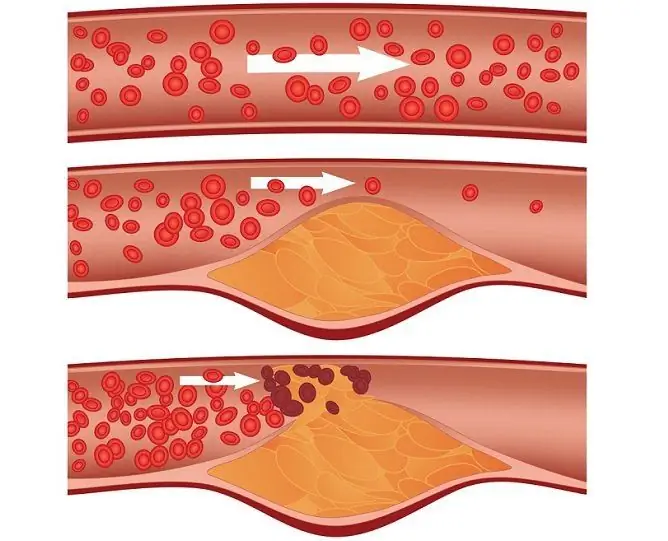- Author Rachel Wainwright [email protected].
- Public 2023-12-15 07:39.
- Last modified 2025-11-02 20:14.
Postpartum urinary incontinence

Postpartum urinary incontinence is a pathological condition in women in which involuntary urination occurs. Postpartum involuntary urination is more often referred to as stress urinary incontinence, when discharge occurs during exercise, laughing, sneezing, coughing, intercourse (in cases of a sharp increase in intra-abdominal pressure).
Urinary incontinence is not a disease, but a disruption in the normal functioning of the urinary system. Urinary incontinence is a postpartum complication that occurs in 10% of women during their first pregnancy and childbirth, and in 21% of women during their second and every subsequent pregnancy. With natural childbirth, the likelihood of developing urinary incontinence is slightly higher than with a cesarean section.
Postpartum urinary incontinence is not a natural condition for women and requires correction. The urinary function is restored on average within a year. In some cases, self-recovery does not occur. Urinary incontinence does not pose a significant threat to a woman's health (in the absence of complications in the form of inflammatory and infectious processes), however, it significantly reduces the quality of life. With timely diagnosis and correct therapy, postpartum urinary incontinence is completely eliminated. If the problem is not diagnosed in time and measures are not taken to normalize urination, the condition may worsen over time. Neglected cases are much more difficult to correct and are characterized by frequent relapses.
Causes of urinary incontinence after childbirth
The main cause of urinary incontinence after childbirth is the stretching and weakening of the pelvic floor muscles, which provide sufficient support for the uterus throughout pregnancy.
The pelvic floor is a powerful musculo-fascial layer that serves to maintain internal organs, maintain their normal position, regulate intra-abdominal pressure, and also contribute to the expulsion of the fetus during childbirth, forming the birth canal. Stretching of the pelvic floor muscles occurs under the weight of the uterus and the developing fetus in it. Difficult childbirth, large fetus, birth trauma are also causes of muscle weakening.
Postpartum urinary incontinence is caused by:
- Violation of the innervation of the muscles of the pelvic floor and bladder;
- Violation of the closure function of the urethra and bladder;
- Pathological mobility of the urethra;
- Instability of the position of the bladder, fluctuations in intravesical pressure.
There are a number of risk factors that contribute to the development of urinary incontinence after childbirth:
- Heredity (genetic predisposition to the development of a disorder);
- Features of the anatomical structure of the pelvic organs and pelvic floor muscles;
- Neurological disorders (diseases of the nervous system, multiple sclerosis, Parkinson's disease, as well as spinal injuries);
- Surgical interventions during childbirth and birth trauma;
- Large fruit;
- Excessive weight gain during pregnancy.
Symptoms of urinary incontinence after childbirth
In medical practice, there are 7 main types of urinary incontinence:
- Urgent urinary incontinence - voluntary urination with a sharp, strong urge, uncontrollable;
- Stress urinary incontinence - urination during any type of physical activity, increased intra-abdominal pressure;
- Ishuria of the paradox or overfilling incontinence - urine flow with a full bladder;
- Reflex incontinence - urination when exposed to provoking factors (loud scream, fright, sound of water);
- Bed-wetting;
- Involuntary persistent urine leakage;
- Leakage of urine after complete urination.
Postpartum urinary incontinence is often referred to as stress incontinence (SUI). For an accurate diagnosis, a comprehensive examination is required.
Postpartum urinary incontinence is diagnosed when a woman has the following symptoms:
- Regular episodes of involuntary urination;
- Significant volume of urine with each episode;
- Increased urinary excretion during physical activity, stress, during intercourse.
In case of irregular episodes of involuntary urination, you should also see a doctor to correct the condition. It should be noted that isolated cases of involuntary urination in small volumes are also characteristic of a healthy organism.
Postpartum urinary incontinence: treatment and prognosis
The treatment of urinary disorders should be approached correctly. Many women ignore the problem, and, without going to a doctor, try to fix the problem on their own or come to terms with this pathological condition. For urinary incontinence after childbirth, treatment involves conservative and radical methods.

In case of urinary incontinence, it is not recommended to self-medicate, as this condition requires careful examination to exclude possible inflammation and infectious causes of incontinence.
For urinary incontinence after childbirth, treatment does not involve the use of medication. Medicines are prescribed in cases of complications of urinary incontinence by an inflammatory process or infection.
Diagnosis of urinary incontinence is made by the following methods:
- Collecting anamnesis (subjective signs of the patient, characterizing the violation);
- Examination on a gynecological chair;
- Cystoscopy (endoscopic examination of the bladder);
- Laboratory tests;
- Ultrasound;
- Comprehensive urodynamic study (cystometry, profilometry, uroflowmetry).
Conservative treatments for urinary incontinence after childbirth include physical exercise to strengthen the pelvic floor muscles and step-free therapy, which involves training the muscles by holding certain weights of the increasing weight.
The criterion for assessing the effectiveness of conservative techniques is the complete disappearance of episodes of involuntary urination. On average, the normalization of urination takes up to 1 year.
If conservative methods of treating urinary incontinence after childbirth are ineffective, surgical methods are used to correct the problem. Currently, minimally invasive surgical techniques are being practiced.
The main methods of surgical correction are:
- Urethrocystocervicopexy is a complete surgical intervention to fix the bladder, urethra and uterus. This method is used extremely rarely with a significant violation of the structure of the pelvic muscles;
- The introduction of the gel into the paraurethral space - the manipulation is carried out both in a hospital setting and on an outpatient basis. With this method of correcting incontinence, the risk of recurrence remains high;
- Sling loop surgery - placement of a synthetic loop under the mid-urethra to provide additional support.
YouTube video related to the article:
The information is generalized and provided for informational purposes only. At the first sign of illness, see your doctor. Self-medication is hazardous to health!






